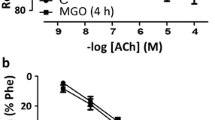Abstract
Acetylcholine-induced, endothelium-dependent relaxation of norepinephrine-precontracted aortic strips, was severely impaired after exposure to a hypoxanthine/xanthine oxidase reaction generating oxygen radicals. This effect was more evident in aortic strips of aging rats (24 months old) in comparison to young rats (3 months old). The addition of authentic ·NO (1 μM) completely relaxed aortic strips exposed to oxidative stress both in young and aging rats. In vitro EPR measurements showed that the ·NO signal was reduced by enzymatic O2-generating reaction.
The activity of a partial purified preparation of constitutive NO synthase from rat cerebellum was significantly decreased after exposure to exogenous oxygen radicals. Pretreatment of aortic strips with 100 μM alpha-tocopherol-phosphate, produced a significant improvement of acetylcholine-dependent relaxation in the aortic strips exposed to oxidative stress, particularly in the aged vessel. The content of malondialdehyde in aortic tissue did not change after oxidative stress or alpha-tocopherol pretreatment. Alpha-tocopherol was unable to recover the NO synthase activity depressed in vitro by hypoxanthine/xanthine oxidase reaction. This study confirms that an oxidative stress impairs the endothelium-mediated vasodilation. Alpha-tocopherol pretreatment protects the vessel against this damage. The mechanism of action of alpha-tocopherol is unknown, but seems unrelated to an antioxidant activity.
Similar content being viewed by others
Abbreviations
- ACh:
-
acethylcholine
- EPR:
-
electron paramagnetic resonance
- ROS:
-
reactive oxygen species
- MDA:
-
malondialdehyde
- NE:
-
norepinephrine
- cNOS:
-
constitutive nitric oxide synthase
References
Laurindo FRM, Almeida Pedro M, Barbeiro HV, Pileggi F, Carvalho MHC, Augusto O, Lemos da Luz P: Vascular free radical release. Ex vivo and in vivo evidence for a flow-dependent endothelium mechanism. Circ Res 74: 700–709, 1994
Rosen GM,Freeman BA: Detection of superoxide generated by endothelial cells. Proc Natl Acad Sci USA 81: 7269–7273, 1984
Matsubara T, Ziff M: Increased superoxide anion release from human endothelial cells in response to cytochines. J Immunol 137: 3295–3298, 1986
Raij L, Nagy J, Coffee K, DeMaster E: Hypercholesterolemia promotes endothelial dysfunction in vitamin E- and selenium-deficient rats. Hypertension 22: 56–61, 1993
Tesfamariam B: Free radicals in diabetic endothelial cell dysfunction. Free Rad Biol Med 16: 383–391, 1994
Zweier JL, Kuppusamy P, Lutty GA: Measurement of endothelial cell free radical generation: evidence for a central mechanism of free radical injury in postischemic issues. Proc Natl Acad Sci USA 85: 4046–4050, 1988
Busse R, Mulssch A: Calcium-dependent nitric oxide synthesis in endothelial cytosol is mediated by calmodulin. FEBS Lett 265: 133–136, 1990
Rubanyi GM, Romero JC, Vanhoutte PM: Flow induced release of endothelium-derived relaxing factor. Am. J. Physiol. 250: 41145–41149, 1986
LaMontagne D, Pohl U, Busse R: Mechanical deformation of vessel wall and shear stress determine the basal release of endothelium derived relaxing factor in the intact rabbit coronary vascular bed. Circ Res 70: 123–130, 1992
Katusic ZS, Vanhoutte PM: Superoxide anion is an endothelium-derived contracting factor. Am J Physiol 257: H33-H37, 1989
Tesfamarian B, Cohen RA: Role of superoxide anion and endothelium in vasoconstrictor action of prostaglandin endoperoxide. Am J Physiol 262: H1915-H1919, 1992
Dinerman JL, Lowenstein CJ, Snyder SH: Molecular mechanisms of nitric oxide regulation. Potential relevance to cardiovascular disease. Circ Res 73: 217–222, 1993
Noack E, Murphy M: Vasodilation and oxygen radical scavenging by nitric oxide/EDRF and organic nitrovasodilators. In: H Sies (ed). Oxidative Stress, Oxidants and Antioxidants. Academic Press, London 1991, pp 445–484
Beckman JS, Beckman TW, Chen J, Marshall PA, Freeman BA: Apparent hydroxy radical production by peroxynitrite: implications for endothelial injury from nitric oxide and superoxide. Proc Natl Acad Sci USA 87: 1620–1624, 1990
Burton GW, Ingold KU: Vitamin E:application of the principles of physical organic chemistry to the exploration of its structure and function. Acc Chem Res 19: 194–201, 1986
Fukuzawa K, Gebicki JM: Oxidation of α-tocopherol in micelles and liposomes by the hydroxyl, perhydroxyl and superoxide free radicals. Arch Biochem Biophys 226: 242–251, 1983
DeGroot H, Hegi U, Sies H: Loss of α-tocopherol upon exposure to nitric oxide or the sydnonimine SIN-1. FEBS Lett 315: 139–142, 1993
Graham A, Hogg N, Kalyanaraman B, O'Leary v, Darley-Usmar V, Moncada S: Peroxynitrite modification of low-density lipoprotein leads to recognition by the macrophage scavenger receptor. FEBS Lett 330: 181–185, 1993
Bredt DS, Snyder SH: Nitric oxide mediates glutamate-linked enhancement of cGMP levels in the cerebellum. Proc Natl Acad Sci USA 86: 9030–9033, 1989
Rubanyi GM: The role of endothelium in cardiovascular homeostasis and diseases. J Cardiovasc Pharmacol 22, (suppl. 4: S1-S14, 1993
Kubes P, Granger DN: Nitric oxide modulates microvascular permeability. Am J Physiol 262: H611-H615, 1992
Guarnieri C, Melandri G, Caldarera I, Scheda M, Ligabue A, Branzi A: Reduced oxidative activity of circulating neutrophils in patients after myocardial infarction. Cell Biochem Funct 8: 157–162, 1990
Marletta MA: Nitric oxide synthase structure and mechanism. J Biol Chem 268: 12231–12234, 1993
Folkow B, Svanborg A: Physiology of cardiovascular aging. Physiol Rev 73: 725–764, 1993
Artur Y, Herberth B, Guemouri L, Lecommte E, Jeandel C, Siest G: Age-related variations of enzymatic defenses against free radicals and peroxide. In: I. Emerit, B. Chance (eds). Free Radicals and Aging. Birkauser Verlag Basel, Switzerland. 1992: 359–367
Tran K, Chan AC, Comparative uptake of α- and γ-tocopherol by human endothelial cells. Lipids 27: 38–41, 1992
Kunisaki M, Umeda F, Inoguchi T: Vitamin E binds to specific binding sites and enhances prostacyclin production by culture aortic endothelial cells. Thromb Haemost 68: 744–751, 1992
Stewart-Lee AL, Forster LA, Nourooz-Zadeh J, Ferns GAA, Anggard EE: Vitamin E protects against impairment of endothelium-mediated relaxations in cholesterol-fed rabbits. Arteriosclerosis Thromb 14: 494–499, 1994
Author information
Authors and Affiliations
Rights and permissions
About this article
Cite this article
Guarnieri, C., Giordano, E., Muscari, C. et al. Alpha-tocopherol pretreatment improves endothelium-dependent vasodilation in aortic strips of young and aging rats exposed to oxidative stress. Mol Cell Biochem 157, 223–228 (1996). https://doi.org/10.1007/BF00227902
Issue Date:
DOI: https://doi.org/10.1007/BF00227902




